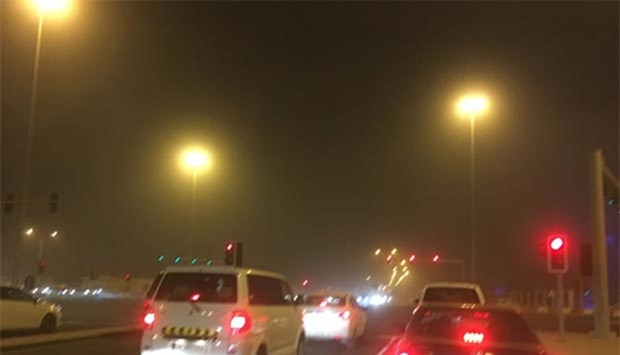Dusty conditions affected visibility in Qatar on Thursday evening while thundershowers, strong winds and low visibility due to dust have been forecast for the southern parts of the country on Friday afternoon.
The Met department said wind speed may go up to 33 knots in the southern areas during rain and thunder.
Visibility, meanwhile, may drop to 3km or less in some places, according to the weather report.
The detailed forecast for inshore areas is that hazy to misty conditions are expected in some places at first, followed by a hot day. There is a chance of localised rain in the southern parts of the country by the afternoon.
Offshore areas are likely to see slightly dusty conditions with some clouds.
On Friday, the maximum temperature is expected to be 40C in Doha, Dukhan, Messaied, Wakrah and Al Khor.
The Met department has also issued a list of safety precautions, prepared in co-ordination with the Ministry of Public Health, in view of the prevailing dusty conditions since Thursday evening.
There were reports of visibility dropping in some areas due to dust and the Met department has urged people to be cautious.
The highest temperature recorded in the country on Thursday was 46C in Batna, Karanah and Turayna, followed by 45C in Sheehaniyah and other places. In the capital, the mercury level kept a comparative low of 40C in the Doha airport area.
Meanwhile, in view of the dusty conditions, the Ministry of Public Health (MOPH) issued a cautionary note, urging people, especially elderly and those with asthma or respiratory diseases, to avoid direct exposure to dust and stay at home unless it was necessary to go out.
Dust consists of particles that are carried by air and could be carried into the lungs. These particles irritate the lungs and cause allergies and exacerbate asthma.
The MOPH has advised residents to follow these tips: Avoid exposure to dust especially if you recently had an eye or nose surgery; ensure all doors and windows are closed properly to prevent dust from entering the building. If needed, use damp towels to seal off any openings in windows and underneath the doors; avoid open areas during the peak of the sandstorm and low visibility; wash your face, nose and mouth frequently to prevent dust from entering your lungs.
The advisory also recommended wearing a protective mask or the use of a dampened towel to cover the mouth and nose. Frequently change the mask or towel and avoid rubbing the eyes to prevent eye infections.
Drivers have been advised to ensure that all windows are closed while driving in dusty weather and only run the air conditioning system when needed. Those working in the open areas have been urged to minimise exposure to dust.
Individuals vulnerable to severe allergies have been asked to start their prescribed antihistamine during sandstorms even before any symptom occurs.
The advisory also urged residents to clean all dust from the house especially bedrooms and bed sheets, after the sandstorm. "Those who may develop watery eyes, cough, asthma or wheezing may report to the nearest health centre and report to the Emergency Department if you have difficulty in breathing."

Dusty conditions prevailed in many parts of the country on Thursday evening.


